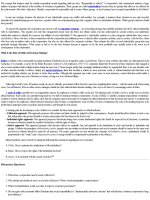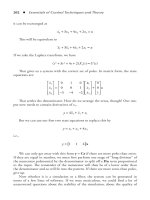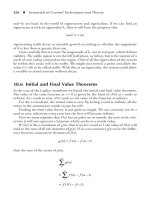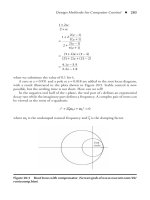ESSENTIALS of Balanced ScorecardMohan phần 4 potx
Bạn đang xem bản rút gọn của tài liệu. Xem và tải ngay bản đầy đủ của tài liệu tại đây (160.19 KB, 27 trang )
Summary
Information is no longer power. Relevant information applied to action
is power in corporations. Corporations are suffering from data obesity
and information starvation.The symptoms were discussed.
The ecosystem that feeds a Balanced Scorecard is made up of vision,
mission, values of the corporation; the competencies of the organization
and the strategy.Without these preconditions, BSC cannot function well.
Performance measures and their nature were discussed.Output, out-
come, and feedback measures were outlined and the between leading
and lagging indicators; the relationship between co-related and non-
co-related indicators were also explored.We introduced the four general
perspectives of BSC:
1. Financial
2. Customer
3. Internal
4. Learning and growth
These perspectives form the balance in the scorecard, but it is not re-
quired that all four be represented. Nonprofits and mission-based orga-
nizations tend to include mission as the fifth perspective as an example.
57
From Management to Performance Management
4239_P-03.qxd 3/11/04 2:35 PM Page 57
4239_P-03.qxd 3/11/04 2:35 PM Page 58
Mission, Vision, Values:
The Precursor to
Balanced Scorecard
59
CHAPTER 4
After reading this chapter, you will be able to
•
Understand what the many definitions of strategy are.
•
Understand why strategy is important to BSC.
•
Understand what the key elements of strategy are.
•
Understand why strategy is not operational excellence.
•
Understand what a mission is.
•
Understand what vision is.
•
Understand what values are.
•
Understand why mission, vision, and values are important to
BSC.
T
he CEO of a multibillion-dollar firm attended a presentation, from
a certain consulting firm, about Balanced Scorecard.The consulting
team, sponsored by internal vice presidents, presented the Balanced
Scorecard framework with all its glory, connecting strategy to operational
action, balancing key perspectives, and driving for key leading and lag-
ging indicators.
Well prepared for the meeting, this CEO said, “I like the story, but
don’t you think we need to know our strategy, define our mission,
values, and vision before we embark on operationalizing this strategy?
4239_P-04.qxd 3/11/04 9:13 AM Page 59
That would mean we cannot do BSC before we satisfy the conditions to
enable Balanced Scorecard.”
What do you think? Should this CEO agree to continue the project,
or should he ask for strategy work to commence?
Balanced Scorecard: The Digestive
Tract of Strategy
Henry Mintzberg once stated the strategy is not the consequence of
planning but the opposite, its starting point. He confirms what is in-
stinctive in all leaders that to do, one must plan and to enable others to
do, one must first create the playing field of action while bounding it
with strategic intent.
Strategy cannot be left to interpretation. Many people have defined
strategy as the things a corporation does to achieve goals; others have said
that strategy is about staying fixed in a changing market. One can say the
strategy is about positioning in the marketplace.They may be all right but
still misplaced in their definitions.The essence of strategy is the science
and art of devising plans to win over customers and other stakeholders.
Webster’s
1
defines strategy as
•
The science and art of employing the political, economic, psy-
chological, and military forces of a nation or a group of nations
to afford the maximum support to adopted policies in peace
and war
•
The science and art of military command executed to meet the
enemy in combat under advantageous conditions
•
A careful plan or method
•
The art of devising or employing plans or stratagems toward a
goal
Strategy is about engaging in battle with the enemy. Many people don’t
like the battle analogies, but in business this analogy does hold true.
60
ESSENTIALS of Balanced Scorecard
4239_P-04.qxd 3/11/04 9:13 AM Page 60
When a for-profit business wins a customer, they take away revenue
from other competitors and hence, destroy the economics of their com-
petitors.This can be symbolic to battle. Strategy is the art and science of
this economics driven to action plans. In strategy, corporations are using
the art and science of exercising command and also employing all avail-
able resources for maximum support of policies and strategic themes.
Strategy is about striking under advantageous conditions.
The essence of strategy is neither winning nor formulating to win.
Under this description, strategy is about executing a plan or a set of plans.
How does a corporation measure whether a strategic plan is a good one?
Corporations can measure strategic themes in the following ways:
•
Is it consistent?
•
Does it address the needs of the stakeholders—that is,
customers, shareholders, and employees?
•
Does it affect the economics of the company positively?
•
Does it affect the economics of key competitors negatively?
•
Is it actionable?
•
Does it have too many moving parts? Does it require too many
conditions to be realized before it works?
•
Are the assumptions consistent and within range of reason and
bounded by real data?
•
Does it have counter strategies built into the plan? What if the
conditions are not satisfied?
•
What if any one element of the strategy fails to be realized—is
it fault tolerant?
•
Is it easy to communicate?
•
It may make you better, faster, and cheaper, but does it make
you different?
•
Is it a unique contribution to the marketplace?
•
Does it gather an unfair percentage of the customers’ percep-
tion of value?
61
Mission, Vision, Values
4239_P-04.qxd 3/11/04 9:13 AM Page 61
•
Is it time-dependent, or can it wait?
•
Does it clarify the ideal customer target?
•
Is it motivating with purposeful action?
How Is a Strategy Realized?
Frankly, a strategy cannot be divorced from its effective execution. One
never knows until it is executed upon. Ironically, corporations are exe-
cuting to a plan, daily.The question is,“Do we have a strategy behind it?”
When employees at all levels of management wake up every morning and
know why they are coming to work and what they have to do to advance
the purpose of the organization, then strategy is realized. Strategy is not
just about action but about focused action.This action is more about what
is rejected as alternatives rather than about what is accomplished. For ex-
ample, when a corporation is executing on a stated strategy, it is focused
on who the ultimate customer target is, and it rejects anyone that does not
fit the profile. It also chooses a strict direction in the market, battling only
chosen competitors rather than anyone in their way.
Does Strategy Change When External
Influences Change?
Given that we have just come through a major downturn in the high-
technology industry, we cannot discount the effects of external factors to
market dominance. However, the mark of great companies is the ability
to anticipate external forces while building competencies that allow for
the most advantageous conditions. It is really uphill when the best cy-
clists win. These winners had a plan and waited for the right time to
move ahead. Similarly, great companies build a strategy in anticipation of
situational influences that will affect others. Great companies are acyclic
in their planning.They master the forces within their control and antic-
ipate the effects of other external forces. However, they identify key
62
ESSENTIALS of Balanced Scorecard
4239_P-04.qxd 3/11/04 9:13 AM Page 62
strategic variables in their planning, and if these variables change in the
marketplace, they reconstitute their strategy.
How Much Does Luck Play in Strategy?
It has been said that luck is the idol of the idle. Luck and timing are major
factors in strategic success. But the assumption that strategy depends on
luck is the wrong assumption. Strategy is a defined approach to the mar-
ket, using the strengths and weaknesses of the markets and the corpora-
tion against the competitors in winning customers. Strategy is longer
term than luck can anticipate. Execution depends on luck and timing, but
strategy depends on longer-term elements. Howard Shultz, of Starbucks,
decided that he was not just selling coffee but that Starbucks was about
people selling coffee. Luck had nothing to do with this inspiring under-
standing of the market.After years of toil and trouble, this strategy is suc-
cessful with epic proportions. It is found every time one engages with a
Starbucks barrister—you can see strategy in action in their eyes.
Ralph Waldo Emerson once stated that shallow people believe in
luck and in circumstances while strong people believe in cause and ef-
fect. Strategy combined with Balanced Scorecard trains and aligns the
competencies within the corporation to uncover luck where it is hiding.
Essential Elements of Strategy
Sun Tzu states that if you know your enemy and yourself, then you can
sustain a hundred battles. In that sense, the essential elements of strategy
are as follows:
Know yourself
•
Your unique attributes are displayed by what you do best.
•
Your strategic positioning is displayed by where you fit in
the marketplace in the minds of your customers and buyers.
•
Know the value that stakeholders will pay for.
63
Mission, Vision, Values
4239_P-04.qxd 3/11/04 9:13 AM Page 63
Know your enemy
•
Understand their strengths and weaknesses
•
Know where they are headed and how they plan to take on
the market.
•
Know how their leadership thinks.
•
Know what they cannot change—that is, how they view
their world, their personality, the unique way in which they
interact with customers, the way they build products or
services.
Know the customers
•
Know what customers value disproportionately.
•
Understand the segments and details of where your future
buyers reside.
•
Recognize that customers are not companies, they are peo-
ple within these companies.
•
Users of your product are not necessarily the ones who pay
for the products.
Strategy Is Not Operational Excellence
Michael Porter, the guru of strategy and Harvard Business School pro-
fessor, highlighted the very key differentiation between operational ex-
cellence and strategy.
2
In this article, he outlines that strategy:
•
Is about positioning in target markets
•
Is about being different and distinctive in the markets
•
Is about delivering a unique value to customers
•
Is about fit—which he defines as the unique combination of
activities that define the corporate identity
He defines operational excellence about improving one activity while
strategy is about orchestrating a set of activities in concert. Consider this
analogy between operational excellence and strategy. Operational excel-
64
ESSENTIALS of Balanced Scorecard
4239_P-04.qxd 3/11/04 9:13 AM Page 64
lence is having the ingredients to a strategy while strategy is having a
recipe for gaining differentiable operational potency.
Strategy as a Portfolio of Competencies
C. K. Prahalad and Gary Hamel, noted authors and thought leaders, de-
clared that large businesses ran themselves as a portfolio of businesses rather
than a portfolio of competencies.They articulated strategy as competen-
cies and their exploitation. For example,Sony has a mission of building ad-
vanced technologies and innovation in the marketplace.Their competency
seems to be in making electronics smaller—miniaturization.
3
Similarly, 3M
Corporation makes many products, but what they have the capability to
do best is adhesive products.
4
Strategy can be defined as the unique, dif-
ferentiating value to the customer that is found in the personality and
learned behaviors of the organization. In this definition, strategy can be the
way the corporation builds and sells products and services. Identifying and
exploiting these competencies is the challenge. New industries can be dis-
covered if corporations can predict the competencies of future target mar-
kets and build them.Corporations that set out to identify future trends and
isolate future necessitating competencies stand to win.
Competencies play a significant role in strategy formulation because
they ground the planning phase with reality check. In strategy sessions,
teams should ask themselves the following questions to ground them-
selves in the reality of their capabilities:
•
Can we accomplish these grand dreams if we cannot execute
them due to the unique skills and learning within the
organization?
•
Do we have to and can we acquire skills and learning to attend
to the changing market demands?
•
Who else can step up and deliver value with lasting competencies?
65
Mission, Vision, Values
4239_P-04.qxd 3/11/04 9:13 AM Page 65
How to Identify, Isolate, and Exploit
Core Competencies
Competencies come in two flavors:
1. First-order competencies. These are the set of skills and capabilities
within the company that if organized well, provides a strong, com-
petitive advantage in the marketplace.The recipe of this mix is key
in delivering true value to the target customers. As an example,
Southwest Airlines has isolated and exploited the key value propo-
sition in their customers that the larger carriers essentially noted
but did not serve. Customers wanted a way to fly short-hauls
within the U.S. and not worry about losing bags and so on.They
wanted to fly inexpensively but were willing to give up luxuries
like food, and assigned seating. In return, they would like to get
out on time and get to the destination on time. Southwest Airlines
knew that flying was a hassle and that customers needed to know
that a fun airline to fly did not mean that the airline did not take
flying seriously. It is in this carefully constructed value proposition
that Southwest airlines opened the skies to many non-flyers. (See
In the Real World,“Taking Flight with Strategy.”)
2. Second-order competency.This works in concert with the unique com-
bination or recipe of activities that form the center of the value
proposition to the customer.This competency is an overriding per-
sonality that an organization portrays to its customers and within.
Consider Sony and how whatever they seem to do, they make things
smaller. C. K. Prahalad and Gary Hamel describe this competency
model extensively in their book titled Competing for the Future.
5
The combination of both these defined competencies form the basis for
whether strategy can be realized.Without capability and uniqueness in
business design, strategy is nothing more than a word.
66
ESSENTIALS of Balanced Scorecard
4239_P-04.qxd 3/11/04 9:13 AM Page 66
67
Mission, Vision, Values
Taking Flight with Strategy
Southwest Airlines, a well-respected airline, originated in Texas to
serve the short-haul markets. Now a strong player in the airline busi-
ness, Southwest has learned to win with strategy. It chose specific
strategic thrusts to drive its business forward. Although initially only
directed tactically at “getting a plane in the air,”
a
Southwest has a
far-reaching mission to provide inexpensive flights attempting to beat
the larger carriers. It focused on key differentiating business archi-
tecture supported with financial attentiveness as seen in the follow-
ing key competencies and activities that they wanted to dominate:
•
Short-haul routes versus hub-spoke flights
•
Kept the planes in the air with on-time, reliable departures
(40 percent pilot utilization
b
).
•
Flew only one form of aircraft Boeing 737s thus driving all
training, learning, maintenance to streamlining and cost.
•
Introduced profit sharing to all employees even before the
union requested this.
c
With profit sharing came an attitude of
cost conservation. There have been noted cases of SouthWest
employees arguing on whether to spend more on items
because they felt it was their profit that is being taken away.
•
Celebrate everything they can in success, but don’t spend too
much money on parties.
•
Low prices, but with acknowledged limited service in-flight and
re-inventing seating requirements
•
Strong humor in delivery of service
Above all, its belief systems have redefined air travel due to its
focus on its delivery and its main cause “a symbol of freedom” as
it alleviates the fear of flying with fun.
a
Public presentation by COO Colleen Barrett, Business Journal Power Breakfast,
Portland, Oregon, September 2003.
b
James L. Heskett, Thomas O. Jones, Gary W. Loveman, W. Earl Sasser Jr., and
Leonard A. Schlesinger, “Putting the Service Profit Chain to Work, Business Classics:
15 key concepts for Managerial Success,” Harvard Business Review, pp. 110–120.
c
Public presentation by COO Colleen Barrett, Business Journal Power Breakfast,
Portland, Oregon, September 2003.
I
N THE
R
EAL
W
ORLD
4239_P-04.qxd 3/11/04 9:13 AM Page 67
Mission Statements
Mission statements live in almost every organization. While strategy is
the unique way an organization goes to market, mission defines the task
at hand that the organization is assigned.
Southwest has a mission framed as “dedication to the highest quality
of customer service delivered with a sense of warmth, friendliness, indi-
vidual pride, and Company Spirit.” Disney has a mission to make people
happy. Often overused and trivialized, mission statements are critical to
the execution or activation of strategy.As discussed before, strategy is the
trigger for a Balanced Scorecard framework. Like coffee pours into a
cup, BSC is the handle and framework that takes the key strategic thrusts,
subcomponents of strategy, into a framework for management, monitor-
ing, measuring, and direction setting.
Why Is a Mission Important to Balanced Scorecard?
Mission statements are not important to Balanced Scorecard as much as
they are important to the drive of an organization. Missions are given to
individuals and organizations. Mission Impossible, the old-time television
series, used the phrase,“If you choose to accept this. . . .” Missions, by de-
finition, have these characteristics:
•
They are targeted and concise.
•
They have strong emotional content.
•
They must have meaning beyond the words on paper but in
the action of the organization.
•
They serve to define the objective of the organization.
The Texas State Auditors Office, which successfully performed Balanced
Scorecard, states its mission as:
To actively provide government leaders with useful information
that improves accountability.
6
68
ESSENTIALS of Balanced Scorecard
4239_P-04.qxd 3/11/04 9:13 AM Page 68
Qsent, a leading provider of contact information to businesses, states its
mission as:
To perfect contact information
7
What makes a mission worthy of attention and effective?
•
Missions identify a reason for existing.
•
Missions are tangible statements of organizational purpose.
•
Missions declare the joint purpose between you and your
stakeholders—namely, your employees, customers, shareholders,
and sponsors.
69
Mission, Vision, Values
Qsent Dials into
Action-Based Values
Qsent, the accuracy leader, holds the following values and associ-
ated principles:
•
Customers define our success. Customers are the focus of
everything we do. Our first responsibility is to understand their
needs and to provide quality products and services more
promptly and dependably than our competitors.
•
Our people make it happen. We treat each other with respect.
People are encouraged to challenge, support, and participate
with each other on adherence to our goals and plans. We
innovate, work, and succeed as a team.
•
We value our commitments. What we commit to, we deliver;
what we are entrusted with, we protect.
Qsent has moved beyond value statements to cover operating prin-
ciples to guide the organization. These underlying operating princi-
ples get to heart of how the organization can function using the val-
ues. Values are what the organization believes. Operating principles
are how the organization acts on these beliefs.
I
N THE
R
EAL
W
ORLD
4239_P-04.qxd 3/11/04 9:13 AM Page 69
Many for-profit organizations derive their mission statements as a key
part of their organizational framework that includes a vision and a set of
values.
Missions are essential part of the Balanced Scorecard for not-for-
profit organizations and sometimes even replace the financial perspective
as a higher-level guiding focus. The State of Texas Auditors Office de-
fined its BSC perspectives to include mission attainment as the fifth per-
spective over and above all others because their financial goals were not
the essential reason for being.
8
They struggled to declare the financial perspective as paramount as
a mission-centered organization. Essentially, the mission statement of any
organization is a perspective, as it is the guiding focus of the organiza-
tion’s other perspectives and must be a balancing force to all other fi-
nancial goals.
Southwest Airlines seems to have galvanized around its mission and
has proven to be guided by very strong operating principles (see In The
Real World in this chapter).
Values
As mission is why an organization exists, values are focused on how the
organization will perform to the mission. Values guide the entire process
of objective setting, goal acquisition, and strategy deployment. In fact, the
key elements of mission, vision, and values drive the entire success of any
organization. Recently, WorldCom and Enron, to mention just two of
many, have put a bright light on the reason why values are important.
Furthermore, these situations in publicly traded companies have shown
the strong relationship between values and the valuation of companies.
Arthur Andersen was a strong, vibrant accounting firm just a few years
ago, and now it does not exist.Values—or the test of its values—made it
extinct in a short period of time.
70
ESSENTIALS of Balanced Scorecard
4239_P-04.qxd 3/11/04 9:13 AM Page 70
Organizations have taken value statements to heart and have found
that any endeavor it performs is dependent on not just the end, but also
the means to that end and values guide this value. It is not important
how to derive value statements because many of the organizations con-
templating Balanced Scorecard have stated values. It is, however, very im-
portant to ask the following questions about the relationship between
values and scorecarding:
•
Do your BSC objectives meet your values?
•
How is your organization deploying BSC using the values as
guide?
•
Are there cases in which the needs of the few outweigh the needs
of many, as in the case of layoffs? Is this a value contradiction?
•
How does your organization view the values? Are they just stated
and forgotten, or do you have examples of their use in business?
•
Does your organization build alliances using values as guide?
In working with the U.S. Marine Corps, most of the work was built
around an understanding of the mission and the values. Being a mission
driven organization built on the purpose of making marines and win-
ning battles, the U.S. Marine Corps tend not to work with organizations
that do not share their value base. From a BSC perspective, values
drive the way in which all activities surround the exercise, for example,
how the team obtains information, how the team communicates, what is
important in the perspectives, how to view learning and growth.
The USMCs values are:
•
Honor. Integrity, responsibility, accountability
•
Courage. Do the right thing, in the right way, for the right reasons
•
Commitment. Devotion to the corps and my fellow marines
I ran an organization, built on values, and believe it to be the funda-
mental framework for work. It was tested everyday in the course of
71
Mission, Vision, Values
4239_P-04.qxd 3/11/04 9:13 AM Page 71
building the organization and was the basis for all managerial action and
effectiveness:
•
Respect
•
Winning
•
Making a difference
72
ESSENTIALS of Balanced Scorecard
Moving from Values to
Operating Principles
In the course of working with several organizations and operating
units, one challenge arises around value statements. People don’t
seem to understand them or value them because they cannot iden-
tify them when they occur in companies and employees only remem-
ber the times when the values were violated in their presence. One
way to ground value statements is to test your teams with the fol-
lowing expectations:
•
Ask members of your team to outline how the values can be
translated to action and record these action methods.
•
Ask members to outline how they want to operate and struc-
ture the way that their values are turned into action, that is,
how they will be expressing the values on a day-to-day basis.
•
Start each exercise with the following frame of reference:
•
For example, I would like to hold one-on-one meetings with
each of the people in my team because I respect my team
members. Note that the operating principle leads the state-
ment and the values end the statement, thus fusing the oper-
ating principle with the value that it expresses and exercises.
•
Make each team member talk through this exercise and
consolidate all feedback into an organizational operating
principle set with examples.
T
IPS
& T
ECHNIQUES
4239_P-04.qxd 3/11/04 9:13 AM Page 72
•
Commitment to excellence
•
Balance
We made all of our decisions based on these values even though they
sometimes contradicted each other. All in all, values drive the how of
business while the mission sets the target.
Vision
A vision is the dream that never leaves you.“Vision is a dream or picture
of the future that draws us—no pulls us into the future.”
9
It is the pic-
ture of what an organization believes the future can be. It details the
world better for the use of the organizations tools, products, and services.
Vision statements show everyone what the world can be.
Vision statements are
•
Significantly motivating
•
A selling document
•
A communications tool used to solicit members and stakeholders
•
A driving dream of the way things can be
Summary
What Are the Many Definitions of Strategy? Strategy has been de-
fined in several ways, but the key descriptors of strategy are described by
Michael Porter, C. K. Prahalad, Gary Hamel, and other thought leaders.
They provide the methods of identifying unique positions in markets.
Why Is Strategy Important to BSC? Without strategy, organizations
cannot isolate key strategic themes to pursue.Without strategic themes, or-
ganizations cannot formulate key perspectives to focus on themes.With-
out the key perspectives, BSC is not a balanced set of perspectives and the
model will break down. BSC is the digestive tract with strategy as its food.
73
Mission, Vision, Values
4239_P-04.qxd 3/11/04 9:13 AM Page 73
Strategic positioning in the marketplace that is the unique and dif-
ferentiable set of activities that define an organization.This unique set of
activities can come together as ingredients into a recipe. One can also
consider that a key element of strategy is the core competency found
within the hearts and minds of the corporation. High-order competency
is an ability to administer key value to the customer that is unique—that
is, the ability of Southwest to deliver on time, fun flight experiences.
What Are the Key Elements of Strategy? The key elements of
strategy are:
•
Know yourself
•
Know your enemies
•
Know your customers
Why Is Strategy Not Operational Excellence? Strategy is about
doing activities differently in the marketplace while operational excel-
lence is about doing different activities.
What Is a Mission?
•
Missions identify a reason for existing.
•
Missions are tangible statements of organizational purpose.
•
Missions declare the joint purpose between you and your
stakeholders namely your employees, your customers, your
shareholders and yours sponsors.
What Is Vision? It is the picture of what an organization believes the
future can be. It details the world better for the use of the organizations
tools, products, and services.Vision statements show everyone what the
world can be.
74
ESSENTIALS of Balanced Scorecard
4239_P-04.qxd 3/11/04 9:13 AM Page 74
What Are Values? As mission is why an organization exists, values are
focused on how the organization will perform to the mission. Values
guide the entire process of objective setting, goal acquisition, and strat-
egy deployment
Why Are Mission,Vision, and Values Important to BSC? Mission,
vision, and values are the basis not just for BSC but for any actions a
corporation will undertake. Without these statements of purpose, the
guiding principles of a corporation will not exist. Guiding principles ar-
ticulate for all concerned the personality of the corporation, and strategy
is a reflection of that personality in action.
75
Mission, Vision, Values
4239_P-04.qxd 3/11/04 9:13 AM Page 75
4239_P-04.qxd 3/11/04 9:13 AM Page 76
Six Success Factors
to Implementing
Balanced Scorecard
77
CHAPTER 5
After reading this chapter, you will be able to
•
Understand the key success factors to implementing BSC.
•
Understand that the success factors are a collection of virtues
that do not guarantee success, but give organizations a guide to
success.
•
Understand that success factors are seldom found in one
organization, but are a collection of factors found in several
organizations that have succeeded not just in BSC, but in im-
plementing other analytic applications and methods such as
activity-based costing, total quality management, and the like.
•
Understand the way these success factors work in concert with
each other to enable a significant and sustainable BSC imple-
mentation.
T
he six success factors covered in this chapter are suggested methods
that combine the success conditions identified by several organiza-
tions. This method is not a cookbook to success but a collection
of conditions found in several successful BSC implementations.
Ironically, the organizational challenges and implications encountered in
4239_P-05.qxd 3/11/04 9:13 AM Page 77
implementing analytic methods like BSC require that implementers
focus on three axes of considerations:
1. The people issues and challenges in change management
2. The process issues that require a removal or and addition of new
processes to enable the transformation
3. The technology that sustains and enables the continuous
improvement
Program initiatives like total quality management (TQM), activity-based
cost/management (ABC/M), customer relationship management (CRM)
and the like have taken these paths over the years, and the knowledge
gained from these implementations is available for comparison to the
BSC challenges. Many of the implementations secrets used in other an-
alytic applications like ABC/M,TQM, and CRM are applicable to BSC
implementation.
Exhibit 5.1 illustrates this combination of insights. Its premise is
“knowing before doing; doing before showing.” Note also that the
78
ESSENTIALS of Balanced Scorecard
EXHIBIT 5.1
Understand the BSC
learning cycle.
Understand
self.
Know the
road map for
implementation.
Treat BSC as
a project.
Use technology
as an enabler.
Cascade the
scorecard.
Six Success Factors for BSC Implementation
4239_P-05.qxd 3/11/04 9:13 AM Page 78
premise contends that organizations have little control over the outcome
of a project; they might have control over establishing the preconditions
of a successful implementation.
Success Factor One: Understand Self
Many organizations seek BSC to mobilize their strategy when they find
difficulty expressing their strategy. Others join the BSC wagon to com-
municate strategy or to operationalize performance measures when they
have a history of incapacity to make and stick to a decision. BSC cannot
solve the problems that are found in the basic building blocks in an or-
ganization. John Lingle and William Schiemann, authors of the article
“From Balanced Scorecard to Strategic Gauges; Is Measurement Worth
It?” confirm that “To the extent that an organization, like an individual,
must ‘know thyself’ to be effective, then executives face an urgent task of
reexamining their measurement system to gain greater self-knowledge
and self-confidence.”
1
Furthermore, BSC will formalize any strategy, if
consistent. It may not be designed to test the viability of the strategy. It
will come close by providing a balanced view of the strategy and allow
for more questions to be asked around measures and around the ability
to mobilize through the organization. But if a company cannot under-
stand its own capabilities or competencies, or has incapacitating habits,
then BSC will not work. Pat Cox, CEO of Qsent, the accuracy leader in
contact information management, understood his organization’s absorp-
tion capabilities early and set about to adjust BSC to fit an emerging
business mentality (see “In the Real World” in this chapter).The organi-
zation should know itself well enough to know what it is willing to do
once armed with BSC information. Organizations have biases and have
ways to solve problems. BSC can only succeed if it adapts to these bias-
es and perspectives.
79
Six Success Factors to Implementing Balanced Scorecard
4239_P-05.qxd 3/11/04 9:13 AM Page 79
80
ESSENTIALS of Balanced Scorecard
Qsent Keeps
Scorecards Simple
Qsent (www.qsent.com), the leader in accurate contact information, is
embarking on Balanced Scorecard even though it is a venture-backed
startup. Pat Cox, CEO of Qsent, emphasizes that the organization is
facing high growth and needs a mechanism to scale its business strat-
egy as well as share its strategy with every employee of the company.
This small startup, with big dreams, has attempted to build perfor-
mance measurement into its fabric but this attempt did not take
hold the first time. The market shifted in midstream, and it had to
refocus not just on balance but also on delivering revenue and noth-
ing else. This focus took it away from Balanced Scorecard for a year.
Now it is re-energizing its entire management team to deliver grow-
ing revenues in these tough times. For Qsent, Balanced Scorecard
is the framework for delivering strategy to its employees and to com-
municate the value of their work.
Francisco Garbayo, senior vice-president of Human Resources, is
leading the implementation. The Qsent board of directors, who have
endorsed the process, looks to him and Pat for a cohesive method
to motivate, measure, and manage the organization’s growth cycle
from startup to enterprise.
In a meeting on scorecarding, Pat’s first instincts about BSC were
that it seemed too complicated for digestion in an emerging com-
pany. He asked that the educational demands on the classic BSC
would take too long and would be challenging for an emerging busi-
ness so focused on the marketplace. However, he realized the value
of a simpler model adjusted for emerging businesses, as he sees
the need for the following:
•
Moving strategy from top management to all employees
•
Managing with the same goals across all his VPs
I
N THE
R
EAL
W
ORLD
4239_P-05.qxd 3/11/04 9:13 AM Page 80
Success Factor Two: Understand the BSC
Learning Cycle
Champions who lead BSC efforts are fast learners who expect others to
move and be motivated by the same ideas and at the same speeds.
Unfortunately, this is seldom the case in organizations. Furthermore, or-
ganizations learn and adopt new methodology differently. But there are
some distinct phases that methodologies like BSC go through. These
phases, once understood, can be enabled for fast organizational absorp-
tion or adoption. Understanding how they evolved in the phases will
help organizations pace themselves and watch for the signs that permit
them to move along in the phases.
Success Factor Three: Know the Road Map
for Implementation
BSC implementation requires focused attention on the people, process,
and technology fronts. Besides all the theory and real-world experience,
this success factor is about what to do to drive the project.There is no
magic in this success factor except for the significant activities that go
into implementing the project using meetings, goals, and objectives, se-
lection criteria for vendors and consultants, choice of champions and
team members, and the attainment of support.
81
Six Success Factors to Implementing Balanced Scorecard
•
Having more than just financial goals to motivate the team
•
Having an understanding of cause and effect in his strategy for
growth
The VP of HR is tasked with creating a simple and understandable
process, advocating the value to the senior management team, and
communicating these objectives with measures and targets with all
of the organization.
I
N THE
R
EAL
W
ORLD CONTINUED
4239_P-05.qxd 3/11/04 9:13 AM Page 81









